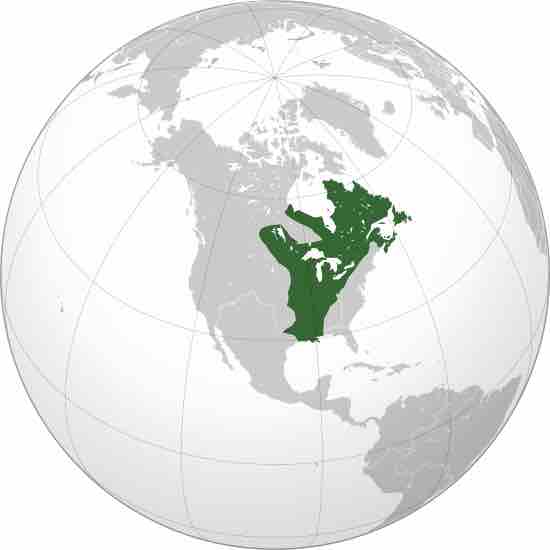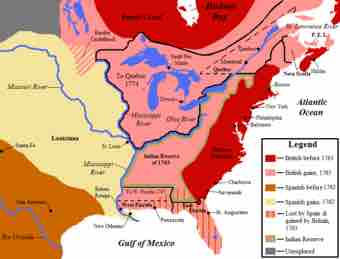Background
New France was the area colonized by France in North America during a period from 1534 until the cession of New France to Spain and Great Britain in 1763. At its peak in 1712, the territory of New France extended from Newfoundland to the Rocky Mountains and from Hudson Bay to the Gulf of Mexico. The territory was then divided into five colonies, each with its own administration: Canada, Acadia, Hudson Bay, Newfoundland (Plaisance), and Louisiana.

New France (orthographic projection)—Maximal expansion in 1712 , before Treaty of Utrecht
This global map illustrates the geographic location of New France, which stretched from Newfoundland to the Rocky Mountains and from Hudson Bay to the Gulf of Mexico.
In 1534, Jacques Cartier claimed the first province of New France. However, initial French attempts at settling the region met with failure. French fishing fleets, however, continued to sail to the Atlantic coast and into the St. Lawrence River. French merchants soon realized the St. Lawrence region was full of valuable fur-bearing animals, especially the beaver, which were becoming rare in Europe. Eventually, the French crown decided to colonize the territory to secure and expand its influence in America.
French Population in its Colonies
For the first few decades of the colony's existence, the French population numbered only a few hundred, while the English colonies to the south were much more populous and wealthy. In 1627, France invested in New France, promising land parcels to hundreds of new settlers with the hope of turning the area into an important mercantile and farming colony. Samuel Champlain was named governor of New France. The colony forbade non-Roman Catholics from living there, and Protestants were required to renounce their faith to establish themselves in New France. Many therefore, chose instead to move to the English colonies.
The economic development of New France was marked by the emergence of successive economies based on staple commodities, each of which dictated the political and cultural settings of the time. During the 16th and early 17th centuries, New France's economy was heavily centered on its Atlantic fisheries. This would change in the latter half of the 17th and 18th centuries as French settlement penetrated farther into the continental interior. Here, French economic interests would shift and concentrate on the development of the fur trade. Furs would soon become the staple goods that would strengthen and drive New France's economy, in particular that of Montreal, for the next century.
Louisiana was an administrative district of New France and was under French control from 1682–1763 and 1800–1803. It originally covered an expansive territory that included most of the drainage basin of the Mississippi River and stretched from the Great Lakes to the Gulf of Mexico and from the Appalachian Mountains to the Rocky Mountains.
New France and American Indians
Although the fur trade was lucrative, many French saw Canada as an inhospitable frozen wasteland, and by 1640, fewer than 400 settlers had made their home there. The sparse French presence meant that colonists depended on the local Algonquian people; without them, the French would have perished. French traders in America quickly realized the economic benefits of working with American Indians to exploit fur and timber exports. The French needed help to survive in the difficult climate of North America, and the Algonquian people were influential in showing them how to establish themselves in this New World. The Algonquian helped them to hunt for food and to use the furs from their prey to keep warm during the winter months. Later on, intermarriage allowed the French to deepen relations with indigenous nations and have access to their hunting and trapping grounds.
French fishermen, explorers, and fur traders made extensive contacts with the Algonquian. The Algonquian, in turn, tolerated the French because the colonists supplied them with firearms for their ongoing war with the Iroquois. Thus, the French found themselves escalating native wars and supporting the Algonquian against the Iroquois, who received weapons from their Dutch trading partners. These 17th-century conflicts centered on the lucrative trade in beaver pelts, earning them the name of the Beaver Wars. In these wars, fighting between rival American Indian peoples spread throughout the Great Lakes region.
Disintegration of New France
The Treaty of Utrecht was signed in 1713 between several European states including Spain, Great Britain, France, Portugal, Savoy, and the Dutch Republic to end the War of the Spanish Succession. The treaty resulted in the relinquishing of French claims to mainland Acadia, the Hudson Bay, and Newfoundland, and the establishment of the colony of Île Royale (Cape Breton Island) as the successor to Acadia.
France ceded the rest of New France, except the islands of St. Pierre and Miquelon, to Great Britain and Spain in the Treaty of Paris in 1863, which ended the Seven Years War (also known as the French and Indian War). Britain received the lands east of the Mississippi River, including Canada, Acadia, and parts of Louisiana, while Spain received the territory to the west—the larger portion of Louisiana. Spain returned its portion of Louisiana to France in 1800 under the secret Treaty of San Ildefonso, but French leader Napoleon Bonaparte sold it to the United States in the Louisiana Purchase of 1803, permanently ending French colonial efforts on the North American mainland.

Map of British and Spanish territorial gains
This map illustrates the British and Spanish territorial gains following the Treaty of Paris that ended the French and Indian War. Also shown are boundary changes within the territory the British had acquired between 1763 and 1783.